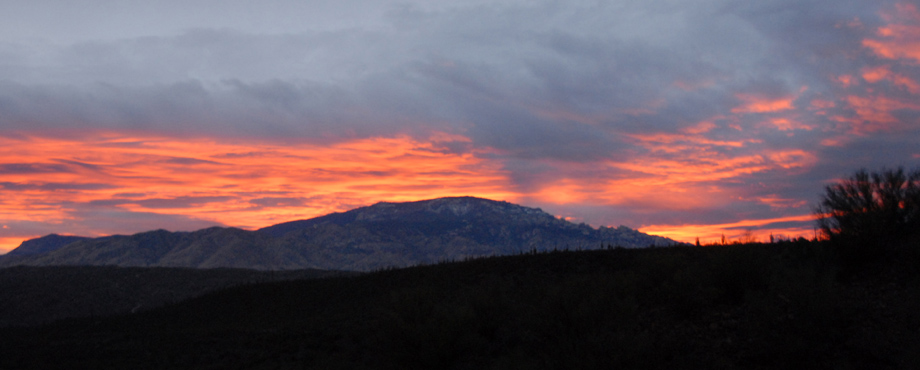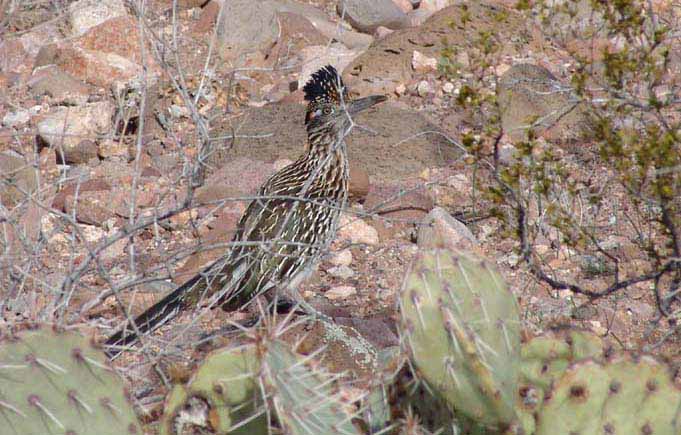Casual Sightings in our area
......................................
March 24, 2010: Sighting of a "Spring Parsley" species, an uncommon flowering plant. For more details, see Purplenerve Springparsley.

March 23, 2010: American Avocet (Recurvirostra americana) sighted on Cascabel Road near The Narrows:
 .
.
Nancy Ferguson and Tom Orum got these images of this shorebird, a rarely-seen visitor to our area. Its distinctive blue-tinged long legs have given it the popular name "blue-shanks". This is a breeding male (the reddish-buff color of the head and neck feathers), and its lightly up-curved bill is visible in the left-hand image. The female's bill has a stronger curvature.
March 2010: Wild Turkeys?! Jim Flood got these images along the San Pedro River not far from Hot Springs Canyon:
 .
. .
.
For more details, see Turkeys.
December 11, 2009: Rincon Peak, Little Rincons, San Pedro River Valley from Lower Hot Springs Canyon:

December 11, 2009: Great Blue Heron at Pomerene Pond:
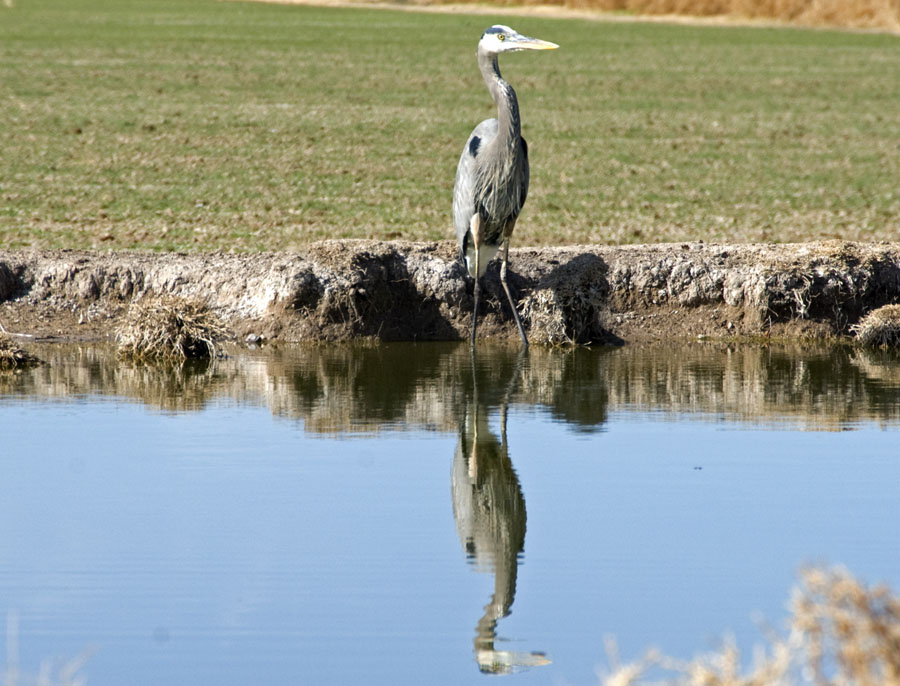
We assume that this handsome creature passed through the Cascabel area during its recent travels. Below, three closer views of the magnificent one (click on each image to enlarge it):
 .
. .
.
May 09, 2009: Cholla bloom, lower Hot Springs Canyon: (click on the image to enlarge it)

March 2009: Redington Pass Sunset:

December 22, 2008: Sunset over Snowy Mica Mountain:
December 12, 2008: Mica Mountain sunset from Lower Hot Springs Canyon:

August 31, 2008: Small spider makes monumental web: near twilight in lower Hot Springs Canyon, we found this beautiful creature in the midst of its equally beautiful web. Only two days later were we able to photograph the web properly, but in order to see that you will have to click on this link: Spiders.

August 31, 2008: Tiny Garter Snake among big brutes: this young garter snake (no more than a foot long) lay prone in the middle of Cascabel Roadway near Milepost 16, between two relatively large Turkey Vultures who stood looming over it, when a slow-moving truck approached and the vultures reluctantly flew off, landing on the ground again a short distance away to observe further developments. For outcome details, see this link: Snakes.

August 31, 2008: Massive Thunderhead over San Pedro River Valley: This cloud was dropping its load on the Dragoon Mountains at 4:36 pm. The view is from upper Mescal Road on the northern bajada of the Whetstone Mountains. (Click on the image to enlarge it.)

From May 6 to June 29, 2008: a Saguaro blossoms and ripens: (Click on each image for a higher-quality view.) Below left, on May 6, this saguaro was showing its first buds. By May 20, the proliferation was surprising. This year seems to have had more intensive blossoming on our saguaros than we've seen in other years. We missed the flowering on this plant, so by June 12, the flower stems were dropping off and the blooms that had been fertilized were now becoming fruit. And at far right, on June 29, one of the fruits has burst open (fully ripe), while the fruit at upper right is getting close to ripeness. Ripening this year is somewhat later than that we observed in, when we conducted a harvest of the plants in this area on June 29, 2002. See this link: Saguaro Harvest June 29-July 2, 2002.
 .
. .
. .
.
June 12, 2008: Ash-throated Flycatcher feasting on bees: This young Ash-throated below was busy catching bees beside a small terrace drinker in lower Hot Springs Canyon on June 12, 2008. Its beauty is such that we recommend further examination at this link: Tyrant Flycatchers.
(Click on the image for a higher-quality view.)
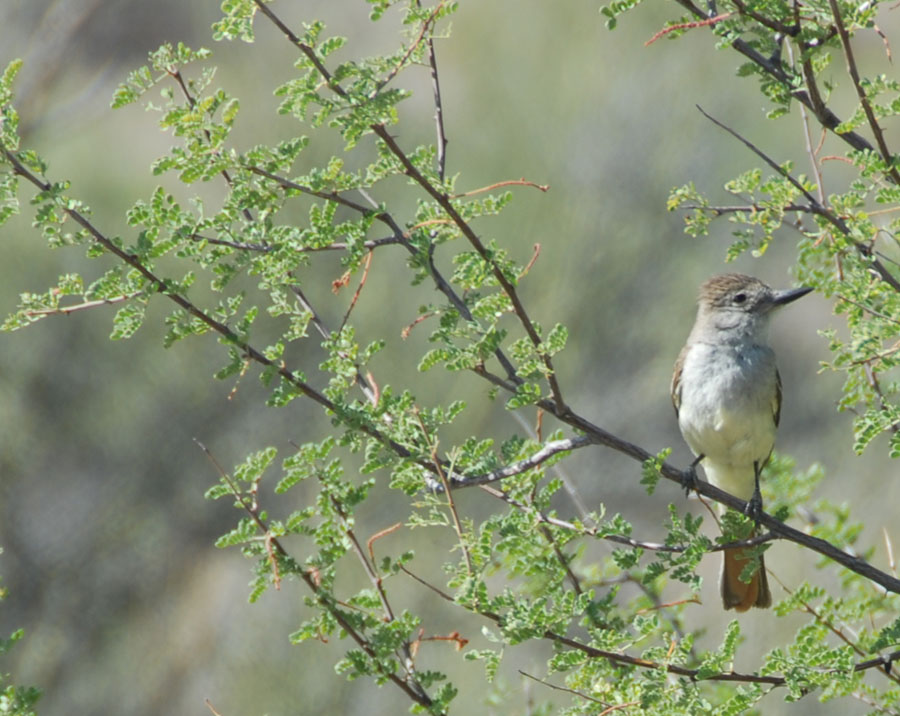
June 10, 2008: Roadrunner nesting in mesquite tree: This Roadie was seen in the evening from groundlevel near the tree. Photography was difficult due to the intervening branches. Click on this link for more details of the episode (and the bird): Roadrunners et al.
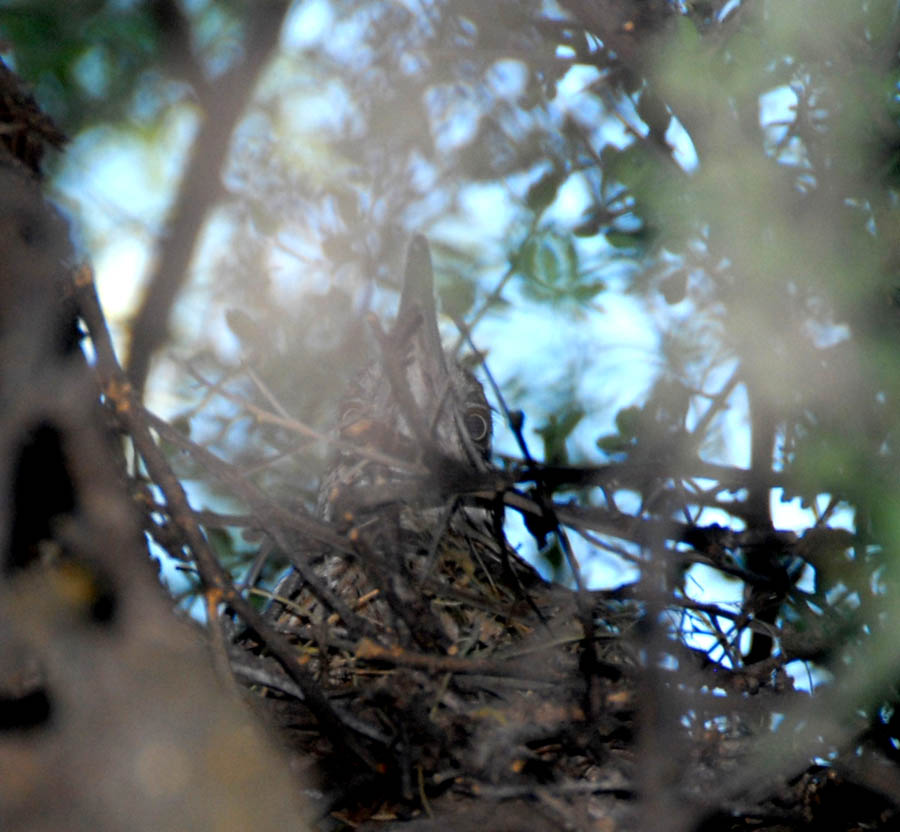
May 13, 2008: Snow on Mica Mountain! In Hot Springs Canyon on this day, it grew quite cold and a very cold rain fell on us. When the sky began to clear, we saw this view of the mountain. Click on the image for a view of lower Hot Springs Canyon (Mica Mountain completely obscured) during the rain episode.

May 3, 2008: Spiny Lizards coming out! This young Spiny appeared on a terrace in Lower Hot Springs Canyon, sunning itself against an andesite rock. We think it is a Desert Spiny, but see Spiny Lizards for more information.

March 13, 2008: The Vultures are back! A high-soaring group over the Cascabel Clayworks, 6:25 pm.

February 21, 2008: The full moon rises over Sierra Blanca at 6:37 pm, on its way to total eclipse. (Click on the image to enlarge it.)

January 7, 2008: At 5:50 am, we drove up the Pool Wash Ridge Road to the Cow Camp located northwest of Sierra Blanca. Below left, just before 7, before returning down-ridge we got this image of the pre-dawn light coming over the hills southeast of the Cow Camp. Below right, driving back down the road, at the point we call "Radio Hill" because it's high enough to catch the Benson Ridge cell phone tower (sometimes!), we got this view looking toward Benson at 7:14. the Huachuka Mountains lie at far center. If you look closely at the image somewhat to the right of and below center, you can just make out faint lights. These are vehicles running along State Highway 90 near Kartchner Caverns. (Click on each image to enlarge it)
 ..
..
Along the ridge at 7:18, we looked below left toward the southwest (Winchesters dominate the background). Near the bottom of the picture toward the middle, you can faintly make out the tall, sheer cliffs along the west bank of the San Pedro near Milepost 17. At 7:59 am, just where the Ridge Road drops down toward the San Pedro, we took this image of the Catalinas shrouded in clouds. The dark conical peak silhouetted against the bright slopes just right of center image is located just uphill from the Redington Pass road. (Click on each image to enlarge it)
 ..
..
Finally, at 8:07 am we got this image of the Sawtooth Ridge of Mica Mountain, illuminated by sunlight streaming through the clouds. (Click on each image to enlarge it)

January 6, 2008: Rain and snow dusts the San Pedro River Valley (momentarily...)! Below left, a rainbow over Pomerene (photographed from the I-10 offramp near Gas City at 12:46 pm; below right, near M.P. 15 on the Cascabel Road at 2:01 pm, we could see that the tops of the Teran-Kelsey escarpment had just been dusted with snow: (Click on each image to enlarge it)
 ..
..
November 15, 2007: Our Ferruginous Hawk has returned to its favorite lookout post in the vicinity of Milepost 19. What a magnificent bird this is. For more details, see raptors.
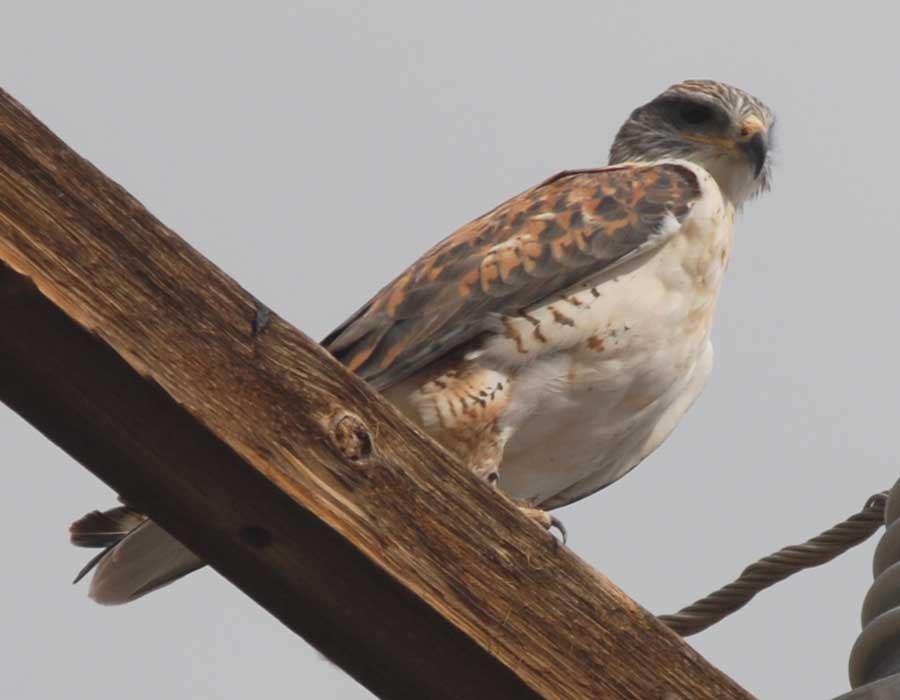
November 8, 2007: in the evening twilight, our entomology naturalist Margaret McClelland sighted this family below, actively occupying a branch of a mesquite tree in lower Hot Springs Canyon. The mother is of course clearly visible, the baby spiders much tinier and were a revelation to observe as they scampered about in the web.

Below, we returned two days later in mid-afternoon, obtaining a much better view of the mother: at left, a dorsal view from the rear; in the middle, a top dorsal view; at right, a ventral image. (Click on each image to enlarge it.)
 ..
.. ..
..
For more details, click on Spiders and scroll down to the bottom of the page.
September 20, 2007: During a visit to the Chihuahuan Desert/Apache Highlands zone at the terrace above Tres Alamos Wash, we espied the following sanctuary inside the barb-spined folds of a Jumping Cholla cactus. Below left, a view of a terrace cholla on the day in question; center, the bird's nest contained within; at right, details of this remarkably well-fortified "Crown of Thorns" nest. (Click on each image to enlarge it.)
 ..
.. ..
..
For more details on the birds probably responsible for this masterpiece, see our page on Mocking Birds and Thrashers.
September 5, 2007: Driving up the Pool Wash Ridge Road near the boundary between Willow Canyon Formation and Cascabel Formation, we were bemoaning the continuing drought (weak summer rainfall in our area), when suddenly we had an unexpected visitor who alighted on a strip of our denim:

(Click on the image for a close-up of the body.) The creature was soon on its way, hopefully, we thought, flying back to water somewhere. This was an unusual event in our experience, so we anticipated finding some water in the Trail Tank, which lay a short distance up-wash to our north. Sure enough, a small quantity of rather brackish-looking water was present there. In our casual ignorance, we assumed it was a dragonfly, but Nancy Ferguson observed that these members of the Odonata Order of Insects lack large antennae, which this creature conspicuously displays. (Dragonfly antennae are "small and bristle-like [setaceous]", says Castner on page 55.) Consulting Castner shows that other details such as eyes, wing structure, etc. don't fit either. It isn't a Damselfly, either. In fact, this is an Owlfly (Order Neuroptera, Suborder Planipennia, Family Ascalaphidae -- see Neuroptera).
May 30, 2007: We saw this remarkable blooming Cholla, below left, near the Community Garden in Cascabel. A variety of insects were visiting the flowers, but among the bees, only native solitary bees were present. The image in the middle shows one of the Solitary Bees and at right an Ichneumon Wasp. The latter, a parasite searching for prey among the pollen-seekers, has a brilliantly glowing red head, thorax, and abdomen. Click on each image to enlarge it.
 ..
.. ..
..
May 5, 2007: Saguaro Juniper cow ambles in general direction of Johnny Lyon Hills paradise.

Man and bull gaze after, holding similarly intense expressions!

Photos by Sue Newman
April 18, 2007: Harvestman sighted on a concrete block in Lower Hot Springs Canyon. This Arachnid, commonly called a "Granddaddy-longlegs Spider", differs from spiders in important ways and belongs to the order Opiliones (see that link for further details). This view below addresses the rear of the animal, with the eye-stalks just visible at the far central part of the cephalothorax. This species might well be named the "Quiburis Harvestman", since the coloring of its body as seen here resembles the strata of our local Quiburis Formation (see Hot Springs Canyon Geology).

January 30, 2007: Snow! ephemeral, of course! Jimmy McPherson and Elna Otter drove into Saguaro Juniper uplands after our unexpected snowfall and got some remarkable images of the area. Below, looking from the Pool Ridge road toward the Paige Formation, along the San Pedro River, near the Paige Wash confluence. Click on the image to go to a web page showing more snow images.

July 2-7, 2006: Rain! Flowing Water!!
Entering Lower Hot Springs Canyon on July 6, after substantial rains earlier in the week, we saw thunderclouds swirling overhead at about 3:30 pm as shown below left, but the rain was falling further north in the Galiuros. The wash had previously run very substantially, but was not running as the vehicle passed at 3:30. However, returning to the wash crossing at 4:30, we found it again running significantly, though (at this point) far less than previously. Click on each image to enlarge it.As you can see from the right-hand enlargement, a line running above the dark tire tracks above the far side of the running water shows how high the wash had run during the previous days. At that level the wash was completely impassible.
 .
.
Early afternoon of July 7, a large and noisy thunderhead below left swirled over Sierra Blanca while rain was falling over the Little Rincon Mountains to the west. Previously the wind was blowing from a northerly direction, but by the time we reached the Cow Camp it swung around from the southeast, and a substantial rain fell for maybe 30 minutes (center), leaving behind delightful images of Palo Verde limbs glistening with raindrops (right, click on each image to enlarge). We estimated about .15 inches from this brief but effective rain, and found, re-measuring the Diversion Tank rain gauge further downslope, a new accumulation of .16". Overall, our raingauges in this area are measuring about 1.4 inches for the Monsoon so far, not much but a real BLESSING in relief of this long-deepening drought. (Sierra Blanca is visible in the right-hand image, hazy in this view from the north, at upper left.
 .
. .
.
The storm just depicted must have hit the Winchester Mountains (as well as further south along the San Pedro River) quite considerably, since on the night of the 7th Hot Springs Canyon ran with a roar, even more strongly than it had in the previous event; the image below left (taken on the following morning) shows the extent of the overnight flooding as viewed from a point just above the dirt road crossing. Below right, the San Pedro River also roared into action during the night, eventually depositing the corpse of an unfortunate cow near the Teran Wash confluence. (Click on each image to enlarge it.) See this link: SJ Current Weather Commentary -- Lynn Smith-Lovin's latest aerial report on the weather.
 ....
....
May 6, 2006: one of the most beautiful Kingsnakes we have seen appeared beside a concrete-based pool in Lower Hot Springs Canyon. See Snakes for more details.

February 21, 2006: Early flowering: We were surprised to find this rather withered Brittlebush below left had put out a few flowers this early in the drought-cursed year -- the mid-day temperature was about 65 degrees. Looking more closely at the flowers, we found that the Sweat Bees were already working these blooms: (Click on each image to enlarge it.)
 .
. .
.
(For more details and imagery, see Solitary Bees.)
January 13, 2006: Near Riot at Jim's Willow Spring! In the face of our continuing drought, it was a pleasure to see that Jim's Willow Spring in Sierra Blanca Canyon was again filling up with water, a condition being exploited by numerous winter residents. For a while this afternoon, the competition for space was becoming intense:

(Click on the image at left to enlarge it.) The main source of the seep is in the foreground of the image, emerging from Cascabel Conglomerate. Most of the birds approaching the spring were Grosbeak-types, including a large flock of Black-throated Sparrows, a solitary male Pyrrhuloxia, and a pair of male Housefinches -- see the images below. A flicker repeatedly approached the water, and an Antelope Squirrel dashed in and out. We saw lots of Javelina tracks, and a few of Coatis.. (For more details and imagery, see Grosbeaks et al.)
 ..
.. ..
..
Amazing sighting of the Century (so far): is it microscopic or macroscopic? Click here and see!
July 28, 2005: Ant swarms tyrannize Cascabel Road: following heavy rains in the Cascabel vicinity on July 27, at sunrise of the 28th massive swarms of flying, reproduction-bent ants -- mostly, it seemed Pogonomyrmex, but we don't really know -- filled the air above the road. Scattered fliers were everywhere, but every few hundred yards there were large swarms. Here are some images: (Click on each image to enlarge it.)
Below, at left you can just see a swarm over the road; at right a close-up view
 ..
..
By 8:30 am, no ants were flying, but at some points on the road large brown masses had formed, which proved to be swarms: (Click on the image to enlarge it.)

For more details, see S-J Ants
May 13, 2005: a problematic bird sighting: three naturalists, Hanna Strauss, Linda Lindsay, and Dick Henderson, spotted this unusual bird in the San Pedro drainage near Teran wash. We photographed it (one of a pair, both fairly large birds, the other one was paler in color). Unfortunately, they were flying fast, and we saw them only at a considerable distance. This one perched, and we used the maximum zoom (optical 7X) on the digital camera to get the best image we could. (Click on each image to enlarge it.)
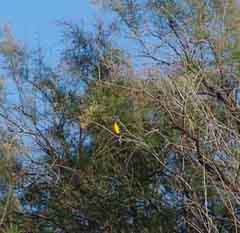 ..
.. ..
.. .
.
This bird poses (to us) a real problem in identification.The bright yellow belly and striped black/white head (white throat) suggest a Greater Kiskadee, but as you can see in all degrees of magnification of the photo, the bird also has a long, downward-dependant tail. The Middle and Right-hand images show a light/dark-banded tail that looks like that of a cuckoo -- it even faintly shows a vertical dividing line, and below the whitish lower belly the feathers are quite dark. None of this matches a Kiskadee. The Yellow-billed Cuckoo occurs in this part of the San Pedro River Valley, but that bird lacks both the bright yellow belly and the black/white head stripes. We could really use some expert help on this one.
March 22, 2005: We saw a Red-tailed Hawk nesting in a high-cliffside nest: (see Birds: Raptors for further details and imagery)

March 12, 2005, a hazy day along the Cascabel Road, was interrupted by this field of orange (mainly Mexican Poppies) draping the foothills of the Little Rincon mountains a short ways upstream from The Narrows. See Flowers for further details and imagery.

January 14, 2005: Packrat encounter in Hot Springs Canyon: See S-J Mammals for further details & imagery.

January 7, 2005: Weather-front cloud formations -- we hoped these were presaging a storm over the San Pedro, but no luck Below left: over the Catalinas; middle, over the Rincons; right, over Benson (Click on each image to enlarge it.)
 .
. .
.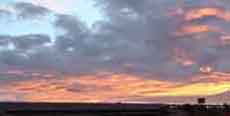

September 25, 2004: Salticid Jumping Spider near Sierra Blanca Spring. See S-J Spiders for further details & imagery.
September 11, 2004: Black-tailed Jackrabbit freezes on a hillside above Lower Hot Springs Canyon. See S-J Mammals for further details & imagery.

September 10, 2004: Praying Mantis with grasshopper breakfast in lower Hot springs Canyon. See S-J mantids for further details & imagery.

September 10, 2004: White Spider encountered on the white flower of a Spiny Poppy in lower Hot Springs Canyon. See S-J Spiders for further details & imagery.

September 10, 2004: Damselflies streamside in Upper Hot Springs Canyon. See S-J Odonata for further details & imagery.

September 9, 2004: Empidonax Flycatcher sits in the afternoons sun at Sierra Blanca Spring. See S-J Flycatchers for further details and imagery.

July 20, 2004: Box Turtle heading for fresh grasses on the San Pedro River terrace near Teran Wash. See S-J Turtles for more details & imagery.

May 31, 2004: Swainson's Hawk perched on a mesquite branch near Milepost 17, Cascabel Road. This hawk is distinguished by its rufous-brown breast, its whitish belly, its white face, and the dark feathers of its wings. Click on each image to enlarge it.
 .
. .
.
May 31, 2004: Ash-throated Flycatcher perched on a ramada beam on a terrrace of Lower Hot Springs Canyon. Note the slightly bushy brown crest, the whitish throat, and the pale yellow of the lower belly. The rufous quality of the tail is nicelyvisible here. This bird made the "pweet" calls typical of the Ash-throated. Click on each image to enlarge it.


March 28, 2004: Ash-throated Flycatcher perched on a mesquite near the Windmill. Note the slightly bushy brown crest, the whitish throat, and the very pale yellow of the lower belly. The rufous quality of the tail is partially visible here. This bird made the "pweet" calls typical of the Ash-throated.


February 27, 2004: Roadrunner captured while running the Lower Hot Springs Canyon Quiburis terrace, making its calls and displaying the distinctive colors behind its eyes: (Click on the image for a close-up)
October 9, 2003: In the aftermath of the latest Baja hurricane, Cascabel finally received a long period of very soft rainfall (about .2" total in some areas). This morning the individual shown below, still bearing remnants of the earth from its burrow, was making its way toward a rich source of forage (just beyond the barbed wire at the bottom of the photo): (Click on the image to enlarge)

October 7, 2003: The latest Baja hurricane didn't bring us much rain on this evening, but it did bring sizeable southerly winds (62 mph at the Cascabel Airport) and angry-looking clouds. The overwhelming quality of the sunset, on the other hand, can only be guessed at in this photo below, taken sometime after 6 pm. (We did get some long-lasting, very gentle rain on October 8.)
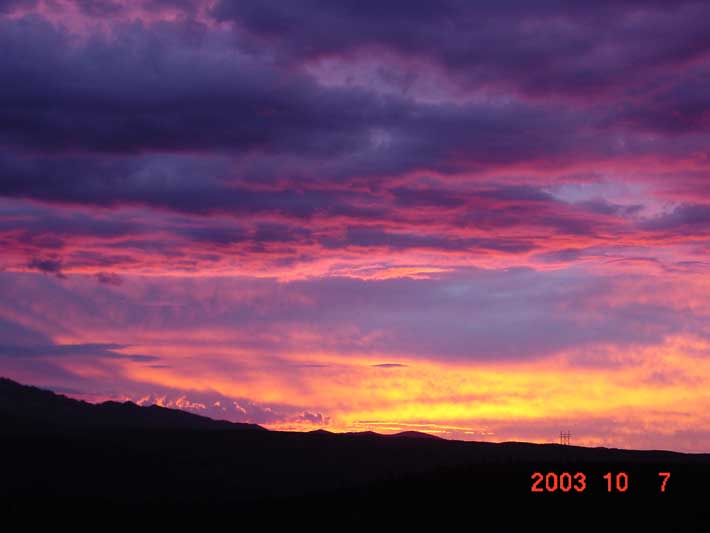
September 21, 2003: a casual stroll up a small Lower Hot Springs Canyon sidewash over the cobbles left from the recent flood, about 9 am, still the cool of morning:

The size of this particular "cobble" was about a man's hand (minus the fingers); Click on the image for closeup! [Clue:"cobble" is at far-left center of the upper right-hand quadrant of the photo, just on the left edge of a patch of bright light; closeup photo was taken from the same angle.]
August 24, 2003: The Barrel Cacti (Ferocactus) and Arizona Poppies (Kallstroemia grandiflora) are blooming in lower Hot Springs Canyon: (Click on images to enlarge)





Datura bloom embraced by visitor: (Click on image to enlarge)

August 2003: Engelmannii Prickly Pears ripen as visitor freezes: (Click on image to enlarge)

July 2003: With the rains in July, Pincushion Mammilaria Cacti have bloomed, providing beetles with lush feed:

June 2003: Water in Hot Springs Canyon has retreated far upstream, but a riparian colonizing grass has spread well downstream beyond this point. The image below contains an image of this grass, located right near the current limits of the water. Help us to identify it, and click on the image to zoom in closer:

March 15, 2003: Desert Marigold with mystery pollinator. Marigolds blooming in Hot Springs Canyon; notice tiny insect on lower blossom; below right: the pollinator up close: (click on 2nd image below to enlarge)
 ...
...
Northern Harrier (?) -- seen near Mile 22 Cascabel Road, August 2002:
This bird was perched on a fencepost and flew off, showing white-black-barred tail feathers (with a black bar at the tip), and dark wings as seen from behind. Note the whiteness of the under-wings and the black trailing edges. The breast is gray and the undertail coverts are white.


Hot Springs Canyon Sunrise, June 28, 2002

.................
Pecan Orchard (Oasis Bird Sanctuary), Cascabel, March 4, 2002
 .....
..... .....
.....
This hawk was hanging out in the Pecan trees, with lots of little birds all around. It looks like a Cooper's Hawk, with its striking white undertail coverts and orange-banded breast. But the eye doesn't look very red.
......................
Cascabel Field Notes: October 9, 10 and 11, 2001
by Nancy Ferguson
Tom Orum, Jeannine Thomas and I spent three days camping near the Saguaro Juniper cattle herd in early October. While we were there we saw some new country and got acquainted with some of our neighbors on S-J land.
CHOLLAS: The cattle were just moving from summer pasture to range on the Cascabel Pasture -- Saguaro Juniper's newest leased land. This was my first chance to get to know it. Our first task was to find a campsite so we parked at the west gate on Gamez Road and hiked southeast. A couple of ridges over, we found two giant, multi-armed saguaros and decided to camp near them. As we walked up to the saguaros, a shiny gray patch of vegetation on the next hill caught my eye -- chollas!
I was thrilled. Years ago, shortly after Judith McBride moved to Tucson, she, Tom and I attended the Tucson Audubon Society's Desert Institute. The Institute is three days of lectures and field trips with experts on the Sonoran Desert. One of the experts studies birds both in Arizona and in South America. He is convinced that tree chollas provide crucial, protected nesting sites for a large variety of birds and that chollas are one of the best indicators of the Sonoran Desert. While I was happy to know this, I was also sad. I knew that Saguaro-Juniper at that time had only a few scrawny staghorn chollas (Opuntia versicolor).
None of them were big enough to provide a nest for a bird. Now I was seeing a cholla forest of large individuals. When we got a chance to visit the cholla patch, they turned out to be chain-fruit cholla or jumping cholla (Opuntia fulgida). Without measuring it, I'd guess the patch covers more than an acre on that one ridge.
Not everybody likes cholla -- especially not jumping cholla. Pat Corbett does not remember the chollas on their Florence ranch fondly. Debbie Hawkins thinks of cholla joints stuck to calves when she thinks of cholla. Jeannine remembers being very careful to avoid this cholla patch when riding Canny to check the cows last winter. I know they have a point -- cholla joints really hurt when they stick you. In spite of that, I am delighted to know that Saguaro-Juniper has such a beautiful stand of mature jumping cholla. To me the chollas mean that S-J is clearly on the edge of the Sonoran Desert and that our land is providing excellent hospitality to nesting birds -- year after year.
A SKELETON: The cows are watering at the North Drinker so Tom, Jeannine and I were spending time there making sure that all the cows were finding the water and getting good drinks. Tom found a skeleton of a small animal about 200 feet north of the drinker and called me in to investigate. It was surprisingly complete. There was the skull, the lower jaw, two paws and a long, long tail. Tom thought immediately that it was a coati (Nasua narica). I photographed the bones as they lay and decided there was no harm I could think of in collecting them. As I assemble them back at home, there is the right shoulder blade, and the whole right front leg including the paw. The hip bones are still attached to the lower back and both leg bones. All of the right hind leg including the big right foot is present. All the tail bones are there and are mostly connected to each other. The last tail bone sticks out at an odd angle. The back bone above the hips is missing and so is the top of the skull. The teeth show very little wear. From these parts I imagine a full grown, young coati who broke the tip of his tail when he was young. Later this imaginary coati roamed around alone as a solitary male. He provided dinner for a hungry bobcat. And the dining room was right there by Saguaro Juniper's North Drinker.
A DRAGONFLY : Many of you know that dragonflies are a real source of joy for me. Nature was obliging this trip. There was a dragonfly at the North Drinker. He was spending time on a stick just south of the drinker and using that as a perch to hunt from. He would sit and wait and watch, then fly out and return to his perch. While he was waiting he was very calm and I was able to get some good photos. When the prints came back, I used the new book Dragonflies through Binoculars to identify him as a Variegated Meadowhawk (Sympetrum corruptum). The species is recognized by its clear wings with red veins, a pattern of red on the gray abdomen and a red face. They are found throughout the west and are said to be at home "in arid, barren country." He must have felt at home by the drinker which is both arid and barren even to my eyes.
So I can report that Saguaro Juniper's Cascabel Pasture is a good place to camp in October. I can only hope that the cows are also enjoying being at home on the range.
Postcript: We took the skeleton in to the Mammal collection at the U of A and we were wrong about the identification. It is a gray fox (Urocyon cinereoargenteus). Guess I'll modify my imaginings accordingly.
..........................................
Got a sighting? Submit it via email to rhenders@email.arizona.edu

Flanks of Sierra Blanca, a herd of about 10 Mule Deer were browsing
Return to Saguaro Juniper Homepage
